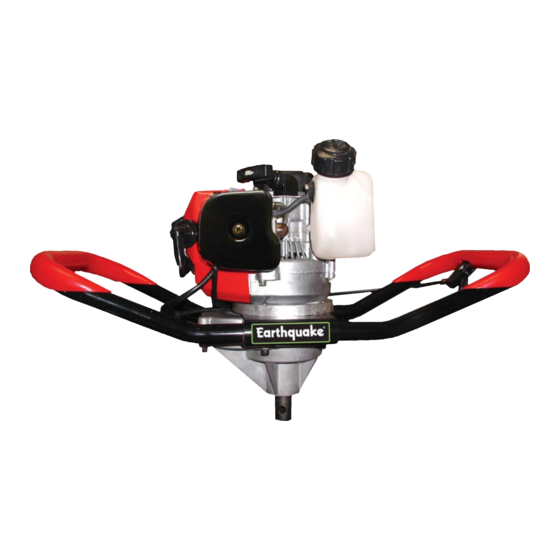- ページ 4
芝生とガーデン用品 EarthQuake E43 earth auger powerheadのPDF 取扱説明書をオンラインで閲覧またはダウンロードできます。EarthQuake E43 earth auger powerhead 17 ページ。 Power earth auger
EarthQuake E43 earth auger powerhead にも: 取扱説明書 (16 ページ)

Earthquake
SAFETY
Engine Safety Precautions
Warning Carbon Monoxide Poisoning
All engines contain carbon monoxide in their exhaust.
Carbon monoxide is a deadly, colorless, tasteless,
odorless gas which may be present even if you do not
smell or see any engine exhaust. Levels of carbon
monoxide, which can be deadly, can be present for days
an enclosed area that has poor ventilation. Any level of
carbon monoxide, if inhaled, can cause headaches,
drowsiness, nausea, dizziness, confusion and eventually
death. If you experience any of these symptons, seek
fresh air and medical attention immediately.
Preventing Carbon Monoxide Poisoning
Never run engine indoors.
Never try to ventilate engine exhaust indoors. Carbon
monoxide can reach dangerous levels very quickly.
Never run engine outdoors where exhaust fumes may
be pulled into a building.
Never run engine outdoors in a poorly ventilated area
where the exhaust fumes may be trapped and not easily
taken away. (Examples include: in a large hole or areas
where hills surround your working area.)
Never run engine in an enclosed or partially enclosed
area. (Examples include: buildings that are enclosed on
one or more sides, under tents, car ports or basements.)
Always run the engine with the exhaust and muffler
pointed in the direction away from the operator.
Never point the exhaust muffler towards anyone. People
should always be many feet away from the operation of the
engine and its attachments.
Gasoline Fires and Handling Fuel Safely
Fuel and fuel vapors are highly flammable. Never use fuel
where a spark or flame may be present. Never use fuel
where a potential source of ignition could occur. (Examples
include: hotwater or space heaters, clothes dryer, electric
motors, etc.) Keep flames and sparks away from engine
and fuel to prevent fires. Fuel fires spread very quickly and
are highly explosive.
Prevention of Gasoline Fires
Never fill your fuel tank with fuel indoors. (Examples
include: basement, garage, barn, shed, house, porch, etc.)
Always fill fuel tank outside in a well ventilated area.
Never remove the fuel cap or add fuel with the engine
running. Stop engine and allow to cool before filling.
Never drain fuel from engine in an enclosed area.
Always wipe up excess (spilled) fuel from engine before
starting. Clean up spilled fuel immediately.
Allow spilled fuel to dry, after wiping and before starting.
Allow fuel fumes/vapors to escape from the area before
starting engine.
Test the fuel cap for proper installation before starting
and using engine.
Always run the engine with fuel cap properly installed
on the engine.
Never smoke while refilling engine fuel tank.
Prevent fire and explosion caused by static electric
discharge. Use only non-metal, portable fuel containers
approved by the Underwriter's Laboratory (U.L.) or the
American Society for Testing & Materials (ASTM).
Do not store engine with fuel in fuel tank indoors. Fuel
and fuel vapors are highly explosive.
Never pour fuel from engine fuel tank.
Never siphon fuel by mouth to drain fuel tank.
Always have an adult fill the fuel tank.
Never allow an adult or anyone under the influence of
drugs or alcohol to fill engine.
Never allow children to fill the engine.
The clutch will transfer maximum power after about two
hours of normal operation. During this break-in period clutch
slippage may occur. The clutch should be kept free of oil or
other moisture for efficient operation.
Page 4
www.ardisam.com
1-800-345-6007
